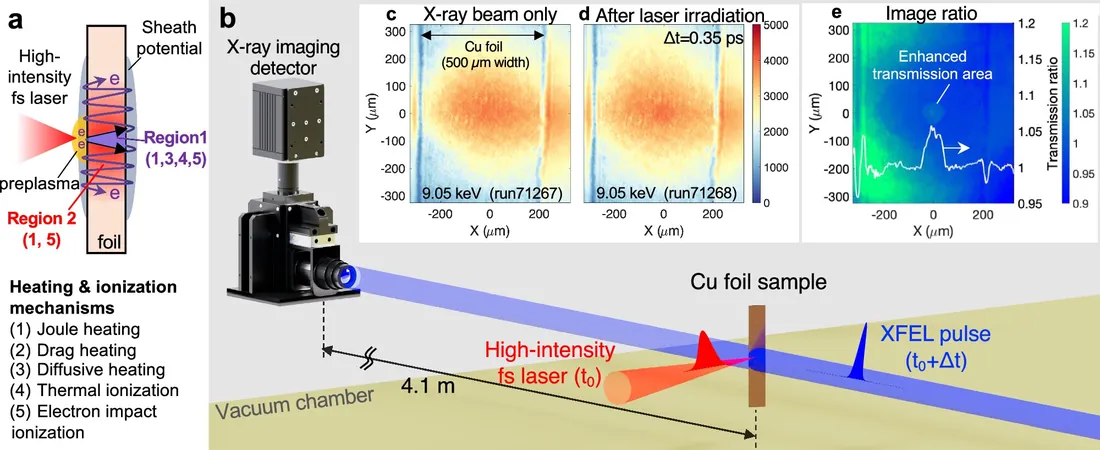
Revolutionary Laser Technique Unlocks Secrets of Plasma Dynamics in a Trillionth of a Second!
2024-09-18
Groundbreaking Ultra-fast Laser Method
In an astonishing leap for the field of physics, researchers have developed a groundbreaking ultra-fast laser method capable of tracking the transformation of copper into dense plasma in just a few picoseconds (trillionths of a second). This process occurs under extreme conditions, where the temperature of the copper skyrockets to nearly 200,000 degrees Fahrenheit, entering a state known as warm dense matter—an exhilarating phase that holds crucial insights for both astrophysics and energy research.
Research Led by Hiroshi Sawada
Led by Hiroshi Sawada, an associate professor at the University of Nevada, Reno, an international team has meticulously outlined their method in a new study published in *Nature Communications*. This remarkable advancement enables scientists to monitor the heating and cooling dynamics of materials post-laser interaction, revealing the intricate processes that occur as a result of high-energy laser pulses.
Utilizing Ultrashort-duration X-ray Pulses
Utilizing ultrashort-duration X-ray pulses from the exclusive X-ray Free Electron Laser (XFEL) facility at SACLA in Japan, the team has developed a way to visualize temperature changes in copper while undergoing transformation into plasma. By employing a technique called pump-probe experimentation, they were able to heat the copper strip with an initial laser pulse (the pump) and subsequently capture images of its state through X-ray pulses (the probe). Each pulsed laser shot resulted in the destruction of a piece of copper, but also yielded invaluable data on its thermal evolution.
Challenges in Capturing Fast Events
Historically, capturing such fast events proved nearly impossible—until now. The research team was able to achieve unprecedented insights into how the warm dense matter state formed, which diverged from their original expectations of achieving classical plasma. “We had some predictions from simulations, but that was totally different from what we saw,” Sawada remarked, highlighting the excitement and unexpected results of their first experiments.
Significance of the Technique
The significance of this technique cannot be overstated. Only three facilities worldwide possess the capability for such intricate pump-probe experiments, including the Linac Coherent Light Source in the U.S. and the European XFEL in Germany. This research not only paves the way for exploring the interiors of giant planets but also holds implications for laser fusion energy research.
Innovative Use of XFEL Pulses
The innovative use of XFEL pulses enables an incredibly precise temporal and spatial resolution, surpassing traditional methodologies. This allows researchers to investigate heat transfer at the atomic level, with heat fronts traveling at nearly the speed of light. As the team plans further exploration, they aim to understand how microscopic imperfections in the materials influence thermal dynamics.
Future Applications and Exploration
Looking ahead, Sawada envisions applications for this groundbreaking method across various fields—plasma physics, high-energy-density science, astrophysics, and even potential advancements in inertial fusion energy systems. Future experiments could utilize facilities like the next-generation MEC-U at SLAC and the NSF ZEUS Laser Facility at the University of Michigan to explore these phenomena under different conditions and materials.
Conclusion: A Turning Point in Understanding Plasma Dynamics
This revolutionary discovery is not merely an academic milestone; it signifies a turning point in understanding how high-density plasmas behave, with vast implications that could redefine our approach to energy sources and planetary science. Prepare for a future where high-powered lasers unveil the mysteries of the universe, one picosecond at a time!

 Brasil (PT)
Brasil (PT)
 Canada (EN)
Canada (EN)
 Chile (ES)
Chile (ES)
 España (ES)
España (ES)
 France (FR)
France (FR)
 Hong Kong (EN)
Hong Kong (EN)
 Italia (IT)
Italia (IT)
 日本 (JA)
日本 (JA)
 Magyarország (HU)
Magyarország (HU)
 Norge (NO)
Norge (NO)
 Polska (PL)
Polska (PL)
 Schweiz (DE)
Schweiz (DE)
 Singapore (EN)
Singapore (EN)
 Sverige (SV)
Sverige (SV)
 Suomi (FI)
Suomi (FI)
 Türkiye (TR)
Türkiye (TR)